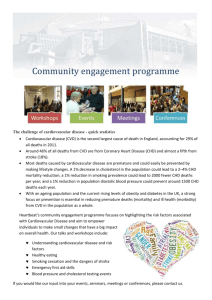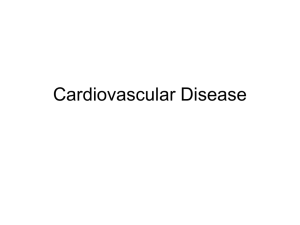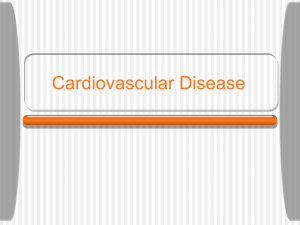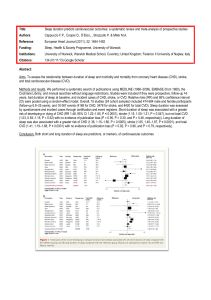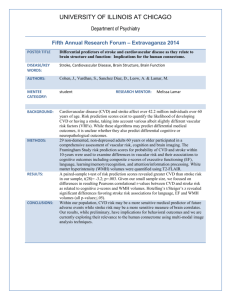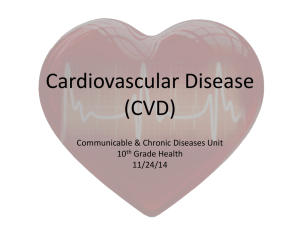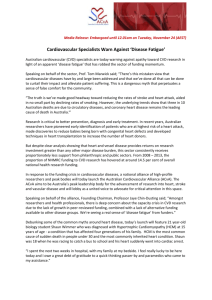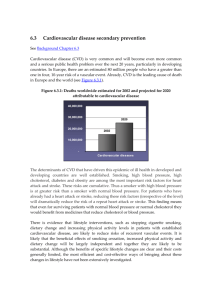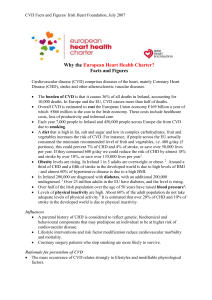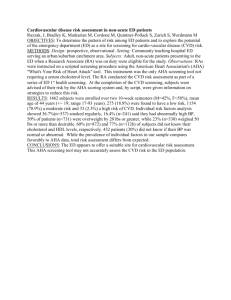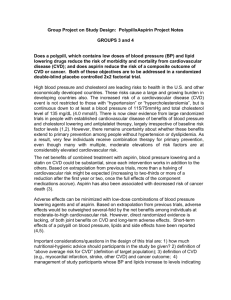SNAB AS TOPIC 1 CARDIOVASCULAR DISEASE
advertisement
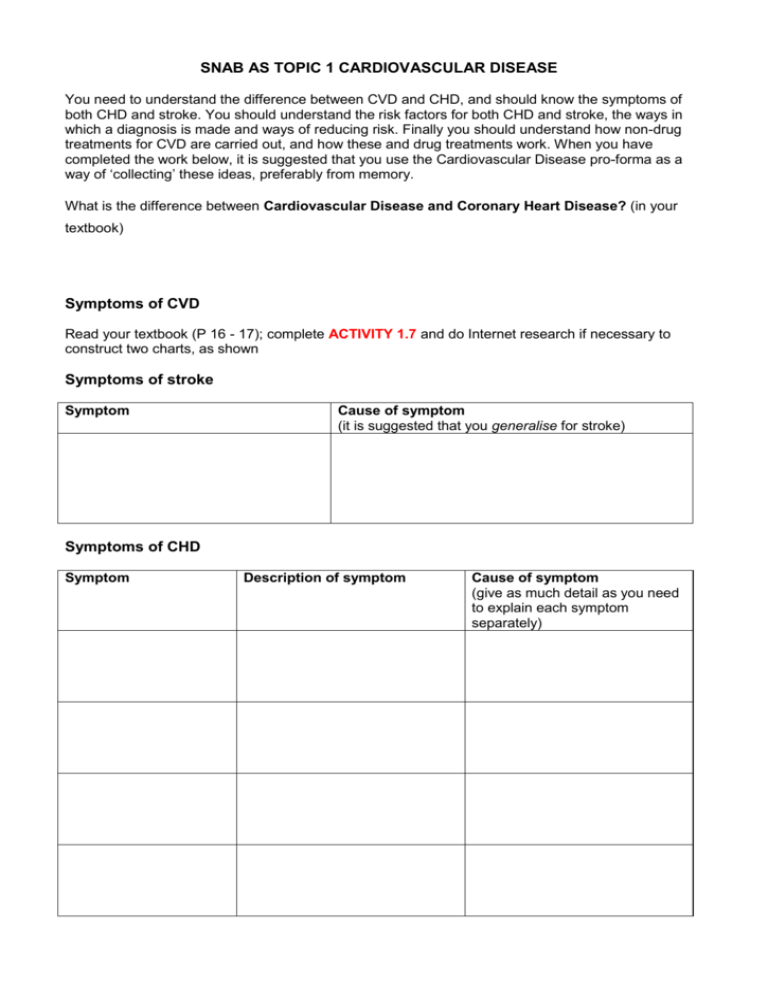
SNAB AS TOPIC 1 CARDIOVASCULAR DISEASE You need to understand the difference between CVD and CHD, and should know the symptoms of both CHD and stroke. You should understand the risk factors for both CHD and stroke, the ways in which a diagnosis is made and ways of reducing risk. Finally you should understand how non-drug treatments for CVD are carried out, and how these and drug treatments work. When you have completed the work below, it is suggested that you use the Cardiovascular Disease pro-forma as a way of ‘collecting’ these ideas, preferably from memory. What is the difference between Cardiovascular Disease and Coronary Heart Disease? (in your textbook) Symptoms of CVD Read your textbook (P 16 - 17); complete ACTIVITY 1.7 and do Internet research if necessary to construct two charts, as shown Symptoms of stroke Symptom Cause of symptom (it is suggested that you generalise for stroke) Symptoms of CHD Symptom Description of symptom Cause of symptom (give as much detail as you need to explain each symptom separately) The lingo There’s an entire language that goes with CVD. Your textbook gives the meaning of these terms. Make sure you know them. It’s extremely unlikely that you’d have to define these in an exam Definition What it means Haemorrhagic stroke Intracerebral haemorrhage Subarachnoid haemorrhage Ischaemia Transient ischaemic attack (TIC) Myocardial infarction Arrhythmia Aneurism DIAGNOSIS We’ve covered this already but make sure you know what information these techniques provide. If you’re interested or if you think you may read medicine at university, do EXTENSION ACTIVITY 1. This time won’t be wasted: these techniques are examined at A2! Technique Information technique provides CT or CAT scan (same thing) MRI scan An ECG RISK FACTORS You have completed Activity 1.10. What was your main learning outcome from this? (Disregard all the information you may have got about probability/stats/use of Excel!) ooooooooooooooooooooooooooooooooooooooooooooooooooooooooooooooooooooooooooooooo Resources for this section: ACTIVITY 1.21 and ACTIVITY 1.22 Textbook P 40 – 45 (take special note of ‘How to get yourself a heart attack’) Powerpoints that you will be shown in class (not mine). URLs on Biology website. RISK FACTORS FOR CVD The three most important risk factors are … 1. 2. Risk factor Age Sex Genes* Cholesterol*2 High blood pressure Smoking Diet XS Alcohol*3 Exercise Stress Why or how it increase the risk 3. * P 40 –41 helps. If you’ve been participating in class discussions you may have other ideas too. *2 You have not learnt the biochemistry of cholesterol yet (it’s coming). Nevertheless, read the section – and here simply remember that it is LDL (‘bad’ cholesterol) that is more harmful than HDL (which is ‘good’ cholesterol) *3 This is hard to understand. Work at it and ask if you need help REDUCING RISK Which of these risk factors have we no control over? Which can, and should, we do something about? Given that people are rarely capable of doing something about ALL their risk factors at once (see QQ 1.37, 1.38 and 1.39) what are the most important risk factors that someone should aim to reduce? Write answers to QQ 1.37, 1.38 and 1.39 below: REDUCING RISK For this section, you should again read your textbook. You also need to complete ACTIVITY 1.24, ACTIVITY 1.25 and ACTIVITY 1.26 The biggest risk factors are … The National Health service advice is DRUG Treatment Diuretics Beta blockers Antihypertensives (You may need to explain the role of the sympathetic nervous system separately here) Anticoagulant drugs (e.g. Aspirin) ‘Clot busting’ drugs (e.g. Warfarin) Streptokinase Statins How the drug helps the patient with CVD Underline (left hand column) those that lower blood pressure Other treatments Treatment Description Coronary angioplasty Coronary by-pass Gene therapy Dietary advice A diet for a CVD patient should be one that is low in It should include key items as shown below Food item Soluble fibre (eg … Oily fish Vegetable oils Vitamin E Fruit and vegetables Garlic Reason for inclusion in the diet How it helps the patient with CVD Stanols and esters (you will need to do Activity 1.27 too) SNAB AS TOPIC 1 CARDIOVASCULAR DISEASE October 14th – 18th - What you must do Hand in Activity 1.10 Decide how you’re going to work: Identify the remaining Activities (mailed to you) from the CD ROM. All are mentioned in the text, but they are ACTIVITY 1.7, 1.23, 1.21, 1.22, 1.24, 1.25, 1.26 and 1.27. You should also look at all three EXTENSION ACTIVITIES if you have the time. Check to see if any require software which may only be on LC1 computers (I think there are no animations). If you have problems with Internet access, you need to download them in your LC1 lesson. Start work on cardiovascular disease. Three choices 1. Write it all out by hand 2. Download Cardiovascular Disease from Ringwoodbiology website as a pdf. Then write on it. 3. Download Cardiovascular Disease from Ringwoodbiology website as a Word document. This allows you to alter the spacing very easily, so that, if a table, for instance, requires more space, you can allow for it. You should have answered EVERY question in the textbook for Topic 1. When you’ve completed this work, use the Cardiovascular Disease pro-forma (also on Ringwoodbiology) as a means of revision. You are welcome to have hard copy, but the document is on the website so that you can use several copies as part of your revision process. Reminder: Biofacts sheets (on Network) are useful. There is also a useful CDROM on the Network (Windows – Subjects – Science – Bio. It’s called ‘Aircom’ & has a blue icon) Next week: Monday period 1 (12d) and Wednesday period 1 (12b) you will be set the on-line end of unit test. Make sure that you have completed all the Review Tests (these are designed to boost GCSE knowledge). If you haven’t finished all work on lipids with CSE/MWK this will be taken into account. We begin Topic 2 next week. Next term (so that you have half term for revision) you will have a written test. In addition to AS exam questions, some questions will be taken from the textbook. After the written test, you can borrow past paper questions. HAND-IN DATE FOR CVD work is Monday October 21st (12d) or Wednesday October 23rd (12b) MAKE SURE THAT YOU HAVE A COPY OF THE SPECIFICATION. YOU NEED THE LEARNING OUTCOMES FOR REVISION. THESE ARE WHAT THE EXAMINER IS ALLOWED TO TEST YOU ON! THE SPECIFICATION IS ON THE BIOLOGY WEBSITE.
